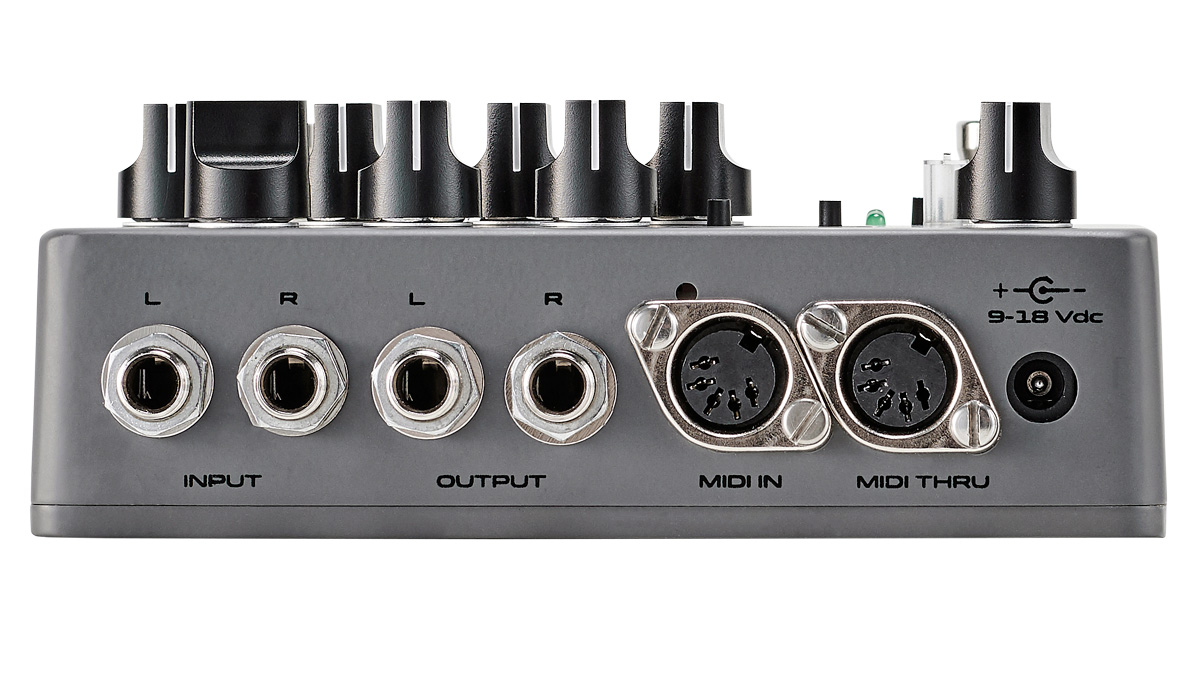MusicRadar Verdict
Having delay and reverb in one pedal is an idea that really works, and it’s implemented here in a way that few could find fault with.
Pros
- +
Delay and reverb in one box.
- +
128 onboard accessible memories.
- +
Dynamic Expression.
Cons
- -
No direct expression pedal input,
- -
Exchange rate makes American pedals overly expensive.
MusicRadar's got your back
Pedal designers may know their jobs, but the input of a pro guitarist in the design process ought to ensure that a pedal ticks the right boxes for players.
So it was that Seymour Duncan enlisted the services of Mark Holcomb from djent-metallers Periphery to help create the Dark Sun. What they’ve come up with is a pedal to provide space and ambience by putting reverb and digital delay in one box with plenty of adjustable parameters, a choice of options for combining the effects, and 128 onboard presets.
The Dark Sun is capable of full stereo operation as well as mono in/mono out and mono in/stereo out. There are actually four routing options available. You can choose the traditional method of putting delay before reverb, or you can switch that round so that the reverb feeds into the delay for a more diffuse effect. The other two are parallel routings that split the reverb and delay into the L and R outputs with a choice of which goes where.

The delay has standard Time, Feedback and Mix knobs and a range from 50ms up to 4.5 seconds so it’s capable of a full range of delay tasks, from doubling to creating the sort of longer looping delays that let you play along with yourself. A Delay Mode switch offers four different subdivisions for tap tempo for the straight digital delay and also offers four options for changing the nature of the delay.
There’s a Reverse delay and a useful Pattern delay with repeats occurring at quarter notes and dotted eighths. If you’re using both outputs, there are also two ping-pong options to bounce the delays between left and right channels: one for straight delay, one for reverse. Dedicated control for the reverb is kept simple with just knobs for wet/dry Mix and Size (reverb decay).
Sounds
The two Mix knobs ensure that you can have delay or reverb on their own or you can set a blend of the two. Whatever you set up, there’s a range of tweakable parameters for the overall wet signal.
A low-pass filter works well in attenuating low-end murk for more clarity in the effect, while a high-pass filter rolls off top-end, resulting in a warmer sound for your repeats, helping blend them in or emulate analogue BBD and tape echoes, aided by the Saturation parameter that can dial in a gritty lo-fi element. Modulation with adjustable Depth and Rate is also available, from mild chorusing to wilder vibrato effects, and you can set a proportionate blend to determine how much of it is applied to delay and reverb.
Want all the hottest music and gear news, reviews, deals, features and more, direct to your inbox? Sign up here.
If you need straight delay or just a touch of reverb for songs in your set, you’ll find them here, but the real joy comes in using all of the creative ways the pedal offers of combining reverb and delay to conjure up new sounds. Any sounds you create can be stored in 32 banks of four presets and the pedal is shipped with these already filled with loads of great examples for instant use or as starting points for your own tweaking.
In live use, the pedal has a practical set of attributes: its Tap/Presets footswitch offers easy access to tap tempo or the four presets in your selected bank; you can turn the Trails function on and off from the front panel; and there’s a Dynamic Expression facility - a ducker that lets your playing control the effect mix, keeping it in the background when playing harder. There’s no direct expression pedal linkup, but the Dark Sun is MIDI controllable.
Having delay and reverb in one pedal is an idea that really works, and it’s implemented here in a way that few could find fault with. While mixing and matching separate delay and reverb pedals from different manufacturers could give you more choice in the types of delay and reverb available to you, you’d miss out on the easily sorted effect-order routing opportunities here and the valuable ability to store and recall patches where both effects are combined. Some may see a single digital delay with a small number of options and just a hall reverb as offering limited sonic choices, but in practical terms, these sounds are all that many guitarists will need, and having just these endows the pedal with a refreshing simplicity of operation while still being capable of complex ambiences.
Trevor Curwen has played guitar for several decades – he's also mimed it on the UK's Top of the Pops. Much of his working life, though, has been spent behind the mixing desk, during which time he has built up a solid collection of the guitars, amps and pedals needed to cover just about any studio session. He writes pedal reviews for Guitarist and has contributed to Total Guitar, MusicRadar and Future Music among others.

